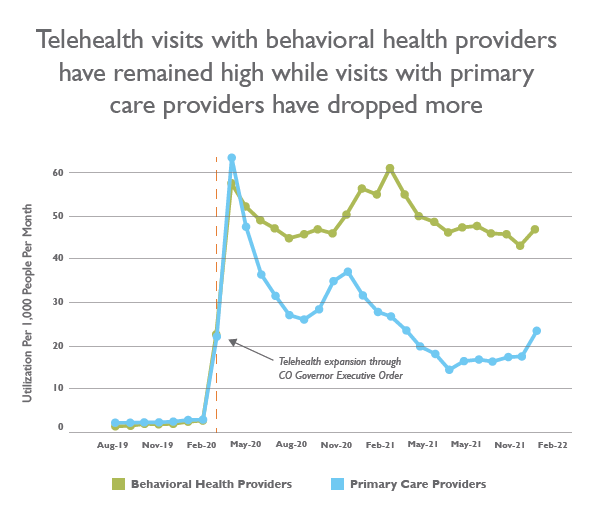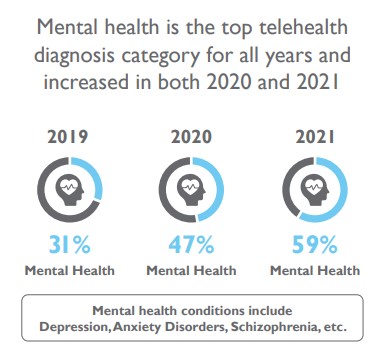The Center for Improving Value in Health Care (CIVHC) released its fifth update to the Telehealth Services Utilization Analysis, which now includes data from January 2019 – January 2022 revealing a picture of telehealth prior to and nearly two years after the onset of the COVID-19 pandemic. The data shows that while telehealth services are slowly leveling out from mid-pandemic heights, Coloradans continue to access services at a significantly higher rate than pre-pandemic, particularly for behavioral health needs.
Overall, while telehealth service utilization is declining from its 2020 peak, when services spiked over 900% from pre-pandemic months, they continue to be significantly higher than pre-pandemic levels. Telehealth service utilization increased by 2,000% from 2019 to 2020, and only dropped slightly (11%) from 2020 to 2021.
When digging deeper into the providers offering telehealth services, behavioral health providers are still providing a high number of telehealth visits compared to primary care providers who have seen telehealth services drop off more significantly since peak levels in 2020.

Included in the updated Telehealth Services Analysis are two new tabs that break out service details and demographic data in greater depth. As in previous updates, mental health conditions remain the most frequent diagnosis for telehealth services. Demand for mental health services has increased every year, representing 31% of all visits in 2019, 47% in 2020 and most recently 59% of visits in 2021.

Breakouts by age in the demographic focus tab further show that mental health conditions are the top diagnosis across all age groups by a significant margin. Mental health conditions represent the top diagnosis for children age 17 and under at 85% of all diagnoses, 93% of all diagnoses among ages 18-44, 75% among ages 45-64, and 49% of diagnoses among ages 65 and over. Further breakouts by race/ethnicity and sex are also available.
While behavioral health providers have continued to experience increasing telehealth service utilization, the focus has gradually shifted from primary care in the past two years. In 2019, primary care providers served the most people via telehealth (42% of visits), followed by behavioral health providers (29% of visits). With the addition of data through 2021, behavioral health providers now service the most people (46% of visits) while primary care visits have dropped to 19% of visits.

CIVHC plans to continue updating the telehealth analysis frequently to enable evaluation of the impact of the COVID-19 pandemic on use of telehealth services and patient outcomes long-term.
- View the interactive report and infographic
- Access the downloadable Telehealth Services Analysis dataset
- More telehealth related analyses from CIVHC:
- View the interactive Telehealth vs. In-Person Utilization Report